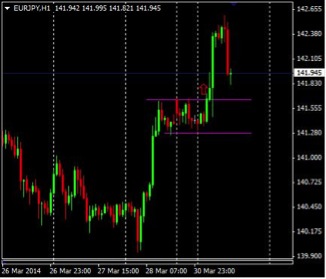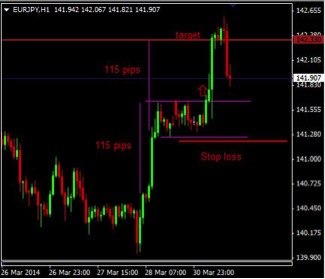Rip, Trip, Rip Trade Set-Up
This is one of my favorite patterns; it is easy to spot and relatively easy to trade. All that is required is a bit of patience, and an eye for spotting the pattern. The pattern occurs quite often, but we only want to trade very strong patterns, as they offer the most promise.
The Set-Up
All the pattern requires is a very strong move higher (or lower) followed by a sideways pause/consolidation.
The pause should account for only a very small portion of the prior run higher (or lower).
For example, in the Forex market if we see a near vertical move higher of 100 pips, the sideways consolidation that follows shouldn’t be more than about 25% of that run up (about 25 pips).
That percentage is just an approximation, but a decent rule of thumb. If the consolidation is too big, say 50%, that means that sellers were able to gain some traction–and we don’t want that.
After a strong rip higher we want buyers to stay in control so we can trade another aggressive pop higher. After a strong drop we want sellers to stay in control so we can trade another aggressive drop lower.
A good example recently occurred in the EUR/JPY (and the USD/JPY and GBP/JPY at the same time)
Figure 1. Rip, Trip, Rip – EUR/JPY 1 Hour Chart

Trading
The simplest way to trade this is to wait for a breakout in the same direction as the prior run. In figure 1 the first strong move was higher, followed by the pause. So when the price breaks higher out of the pause/consolidation, go long (buy calls).
Another way to trade it is to assume the breakout direction will be in the same direction as the prior run. So in figure 1, you could buy anywhere within the consolidation–preferably near the lows of the consolidation.
If the prior run had been down, you could enter a short (put) trade near the top of the consolidation, with the expectation that the price will eventually continue to the downside. Alternatively, you could wait for a breakout to the downside to enter the trade.
Getting in during the consolidation provides a better price, yet the consolidation could last a while. This is a problem for binary options traders since it makes choosing an expiry more difficult.
For traders using traditional markets, getting in during the consolidation reduces risk and increases profit potential, but requires a leap of faith on breakout direction.
If trading traditional markets, the stop is placed just outside the consolidation, on the opposite of the breakout.
A target is established based on the prior run. See figure 2.
Figure 2. Trading Rip, Trip, Rip – EUR/JPY 1 Hour Chart

We measure the prior run and then add it to the bottom of the consolidation to establish an upside target (see purple vertical lines). Notice that I measure the first run based only on the strongest portion (from above the slight pause). This keeps the target a bit more conservative, and also makes sure that the prior run is strong enough to warrant taking the trade. If the prior run has too many pauses we don’t want to trade it–remember, we want a near vertical run before the consolidation.
If the prior run had been down, the distance of that prior run is subtracted from the top of the consolidation to provide a downside target.
A stop is placed outside the consolidation at the time of entry (during consolidation or at breakout).
Final Word
When we have a very strong, near vertical, run higher followed by a small consolidation we can anticipate that the price will break above the consolidation. When we have a very strong, near vertical, run lower followed by a small consolidation we can anticipate that the price will break below the consolidation. The classic approach is to wait for the breakout to occur and initiate a trade–this approach is likely favorable for most traders, unless you are very familiar with reading price action and don’t mind holding positions during consolidations which can play with your mind as the price see-saws back and forth. If the prior move was very strong, the consolidation breakout is typically followed by another explosive move. Don’t get greedy though, if trading traditional markets, keep your target conservative based on only the strongest portion of the prior run. If trading binary options, the breakout trade is usually best, but pick an expiry that allows enough time for the market to clear the consolidation and put you in-the-money. Usually this will be about 2 to 5 bars (actual time will depend the timeframe you are trading).